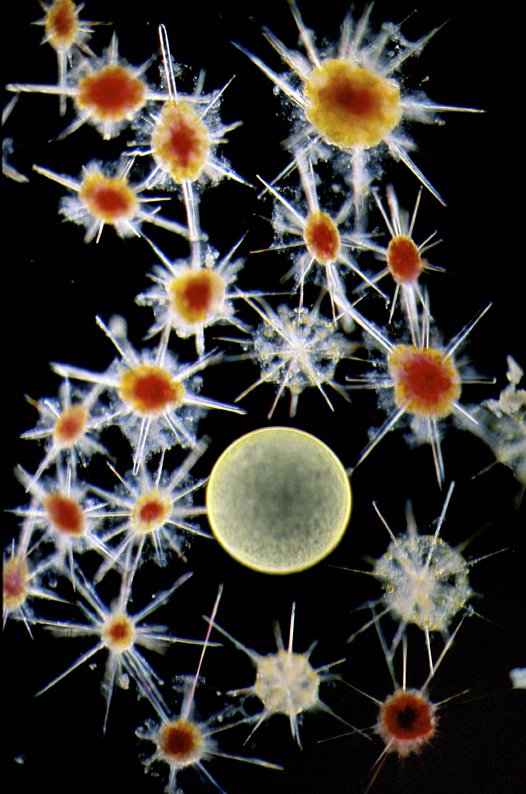Zooplankton
On this page...
What are Zooplankton?
Zooplankton are floating or weakly swimming animals that rely on water currents to move any great distance. They are usually larger than phytoplankton, ranging from tiny copepods, less than a centimetre long, to jellyfishes and colonial salps that may be metres long. There are two major types of zooplankton: those that spend their entire lives as part of the plankton (called Holoplankton) and those that only spend a larval or reproductive stage as part of the plankton (called Meroplankton).
Zooplankton are the favourite food of a great many marine animals so camouflaging themselves is a very important survival strategy. Developing effective camouflage when you live in clear, blue water is no easy matter. The best solution and the one most often used by members of the zooplankton is to be as transparent as possible or, in the case of many surface floating jellyfishes, blue.
Vorticellid ciliate

© Image Quest 3-D
Ciliata derive their name from the Latin word for 'eyelash,' which refers to the short, dense hairlike covering on some or all of the surface of a ciliate. The cilia beat to propel the ciliate through the water and to draw in food particles.
Terebellid worm larva

© Image Quest 3-D
Terebellid worms belong to a group of segmented worms called polychaetes. Polychaete worms are mostly found in marine habitats and are related to earthworms and leeches. Adult terebellid worms live in various types of permanent tubes in the sediment of the sea floor or on the reef, extending long tentacles to feed. Like most polychaete worms the larva of the terebellid worm is free swimming and planktonic.
Scale worm larva

© Image Quest 3-D
Scale worms are another type of polychaete worm which, as their name suggests, are covered in a layer of scales. As adults these scales can be very brightly coloured and patterned. Scale worm adults are mobile but closely associated with the sea floor while the larvae are planktonic.
Mantis Shrimp larva

© Image Quest 3-D
This is the second larval stage of a Mantis shrimp. It is a crustacean, belonging to the same group as crabs and lobsters. With its shield-like carapace and spines, it looks completely different from the burrowing adult it will become.
Copepod Candacia

© Image Quest 3-D
Copepods are tiny crustaceans, belonging to the same group as crabs and lobsters. They are the most abundant multicellular animals in the sea and collectively may outnumber all other animals in the world. Many move with a characteristic 'hop' through the water and form an important part of the diet of many reef fish.
Burrowing Anemone larva

© Image Quest 3-D
Burrowing Anemone larva - Anemones belong to a group called the Cnidaria, which includes corals, hydroids and jellyfish. The adult Burrowing Anemone actually burrows under the sediment of the sea floor. As a larva living in open water, it glides around using microscopic hairs called cilia that cover its body. Burrowing Anemone are fierce predators of smaller plankton, wrapping their arms around their prey and swallowing them whole.
Radiolaria

© Image Quest 3-D
Radiolaria, Phytoplankton - With their glassy geometric skeletons, radiolarians are among some of the most beautiful of all plankon. Their skeletons often have arm-like extensions resembling spikes, which increase their surface area and therefore their buoyancy. They exist in a wide variety of shapes including spherical, cone-like and pyramid forms. Different species of radiolarians also exhibit a wide variety of behaviours. They may reproduce sexually or asexually; be filter feeders or predators; or even live in close association with single celled algae.

